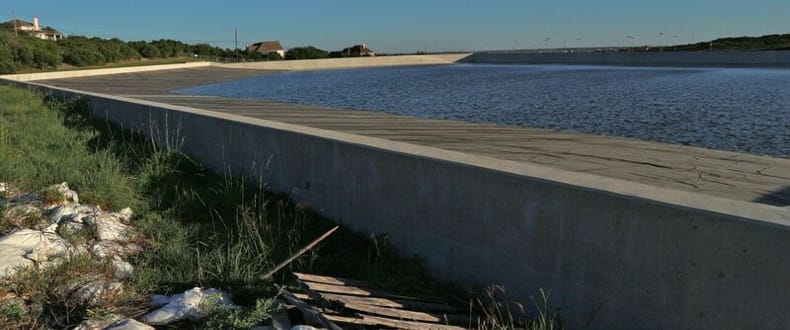
Government agencies, utilities, and industrial customers are increasingly relying on geomembrane solutions for projects that could potentially threaten the environment. Cost-effective due to their ease of installation and proven to be reliable for decades, geomembranes have become a popular front line in protecting natural settings.
Water reclamation is a vital part of the services provided by government and water agencies. The public demands it be done correctly.
A Difficult Task
The city of Austin, Texas needed to line a 101-acre-foot effluent storage pond for a wastewater treatment plant and needed robust geomembranes with long-term service life. The project had a number of factors that made it particularly difficult:
- The pond was in a large commercial development within the Lake Austin and Barton Creek watersheds, and within the Edwards Aquifer contributing zone. It also sat near a 4,000-acre nature preserve with several known endangered species in the vicinity. As such, protecting the watershed and environment were of utmost concern throughout the planning, design, and construction phases.
- The aquifer was the source of Austin's drinking water. The project couldn’t disturb the subgrade beyond four feet.
- The pond had to be able to store wastewater effluent and be in compliance with the Texas Commission on Environmental Quality (TCEQ) standards.
- The state of Texas didn’t allow for direct discharge of effluent along the watershed. All wastewater had to be used for irrigation.
- The effluent from the pond was to ultimately be used as a discounted or free, readily available water source for landscaping and golf course irrigation throughout the Barton Creek community.
The city considered a number of wastewater plant liners, comparing performance specifications and performance history. They ultimately chose the Seaman XR-5® 8138 40 mil geomembrane for a number of reasons:
- It had high strength, tensile, seam properties.
- No protective cover was required.
- The broad chemical and environmental resistance.
- It had minimal field seams.
The Construction
A traditional impoundment is usually made to be at least 20 feet deep and equipped with a sand under-drain system. Because of the four-foot-deep rule due to the aquifer, this pond had to be designed completely differently. The impoundment was completely above-ground, using approximately 7,200 cubic yards of concrete to construct walls up to 3.5 feet thick and ranging in height from four to 32 vertical feet, to accommodate existing topography.
The wastewater plant liner system used 30,000 square yards of double-sided geocomposite for the underliner and a matching 30,000-square-yard, 40 mil ethylene interpolymer alloy (EIA) coated geomembrane. The geomembrane system was only able to be attached at the bottom of the pond walls on an engineered concrete "step" that was poured on top of the pond wall footings. The geocomposite underliner was attached first and the geomembrane was attached just beyond the extents of the underliner using stainless steel batten bar supports with gaskets and a watertight sealant. Elevated air vents were custom-made to allow for the two feet of freeboard the state mandated must be on all wastewater impoundments.
The Results
The finished product is an ideal storage and containment structure that meets all requirements and protects the sensitive environment in which it’s located. The careful development of the project, including the geocomposite underliner and geomembrane, added life expectancy and boosted public opinion due to the owner's commitment to protect the environment.
If you have a challenging need, see how XR Geomembranes can play a key role in the solution. Contact us to learn more about wastewater treatment pond liners.




